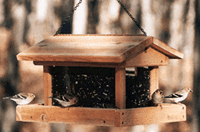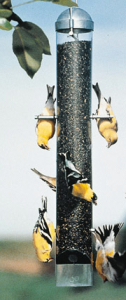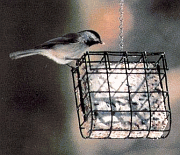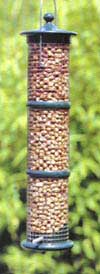

Wood Hopper Feeders
 Wood
feeders, often times referred to as hopper feeders, are probably one of
the first feeders you will buy. The natural look of a wood feeder
blends in nicely with the outdoor surroundings. A well made kiln
- dried cedar feeder will last many years.
Wood
feeders, often times referred to as hopper feeders, are probably one of
the first feeders you will buy. The natural look of a wood feeder
blends in nicely with the outdoor surroundings. A well made kiln
- dried cedar feeder will last many years.
A wood hopper feeder is convenient because you just open the top, pour the seed in and it is fairly well protected from the weather such as rain and snow. A good sized feeder can also mean less trips to refill the feeder and that can be an important consideration on the colder Minnesota winter days.
If you have squirrels in your area the placement of the feeder is an important consideration. Squirrels love to raid feeders of all kinds and a wood feeder may not last long from a squirrels sharp teeth. Squirrels can destroy a wood feeder in no time at all so it's wise to plan the placement of a wood feeder carefully.
Pole mount your wood feeder at least 10 feet away from the nearest tree or other jumping point that a squirrel may launch an aerial attack from. They can and do jump through the air with the greatest of ease! Position the feeder at least 5 feet or higher vertically because squirrels are jumpy little critters.
You can also purchase a squirrel baffle on the pole for additional protection. If you know there are raccoons in your area you would be wise to purchase a baffle designed to keep raccoons at bay and at the same time you will avoid the squirrel attacks.
Sometimes no matter what you do it is impossible to thwart the squirrels. Usually, what the squirrels are after are the black oilers in a seed mix. Some people simply provide the squirrels with a pile of black oilers on the ground at the opposite end of their property from where the wood bird feeder is. Being opportunists, the squirrels will go for the black oilers on the ground where it is an easy source of food and leave your wood feeder alone. But be forewarned that as soon as you forget to provide the squirrels with this easy source of black oilers they will turn their attention back to your wood feeder.
Another trick is to fill the feeders with only Safflower for a while. Squirrels are not particularly fond of Safflower, but even a real hungry squirrel will lower it's expectations and eat Safflower given enough time.
So it's best to pick an appropriate spot in your yard, use the squirrel baffles and keep your fighting with the squirrels to a minimum. Many a man has spent countless hours, days, months, and years trying to outwit the squirrels only to find that his self image is destroyed because of a tiny little creature with the brain about the size of a peanut has outwitted man again. Seeing a man reduced to such a state is a sad thing to witness.
Tube Feeders
 Personally,
I like the Droll Yankee brand tube feeders. The new ones have a
lifetime
warranty which includes against squirrel damage! Now that's a
good
warranty and a good feeder! With other tube feeders I spent a lot
of time using duct tape to repair the less expensive tube feeders and
the
duct tape didn't do much to enhance the look of the feeder and of
course
the squirrels chew through the duct tape even easier than the plastic,
and I thought I even heard a couple of them saying, "Thank You!"
Personally,
I like the Droll Yankee brand tube feeders. The new ones have a
lifetime
warranty which includes against squirrel damage! Now that's a
good
warranty and a good feeder! With other tube feeders I spent a lot
of time using duct tape to repair the less expensive tube feeders and
the
duct tape didn't do much to enhance the look of the feeder and of
course
the squirrels chew through the duct tape even easier than the plastic,
and I thought I even heard a couple of them saying, "Thank You!"
Droll Yankee tube feeders can be pole mounted or hung from wherever you like. While the feeder may have a warranty against squirrel damage, that does not mean it is squirrel proof. It means it is squirrel resistant. It's just nice to know that your not going to find a big hole chewed through the side of your feeder with a bunch of your precious bird seed laying in a pile on the ground. The squirrels will still pilfer some seed from the tube feeder but just not as much and not as easily.
There are a couple of things you may want to consider when looking over tube feeders. By their design they have lets say 4 to 8 perches from where they can eat. But as the seed is lowered in the tube there will be perches that do not have access to the seed because the seed has lowered in the tube. Your either going to leave it that way or your going to be forced to go out and top off the feeder with some more seed if it really bugs you that much. Once you see a cute little bird perched at one of the empty seed ports your heart strings may be pulled enough to make you break down and fill the feeder back up to the top.
Don't despair! There's a way around this little inconvenience. Droll Yankee also offers tube feeders with and extra long extended top. This acts as a reserve area to hold much more seed than the standard design in tube feeders. I have a couple and they were worth the little extra money. They work very good.
Tube feeders may or may not come with a dish at the bottom. A dish is a good idea if you expect and want to see Cardinals at the tube feeder. So buy the dish for it or the Cardinals will not be able to perch on those little perches and you'll miss seeing the Cardinals. Being Minnesotans with a love for Cardinals, we can't have that!
Thistle Feeders
 Thistle
feeders are specially designed with very small holes so that thistle
seed
does not pour out freely onto the ground. These feeders are
mostly
attractive to gold finches, house finches, and purple finches.
Thistle
feeders are specially designed with very small holes so that thistle
seed
does not pour out freely onto the ground. These feeders are
mostly
attractive to gold finches, house finches, and purple finches.
The thistle feeder pictured here is specially designed so the
american
gold finch hangs upside down to eat the thistle. It's fun to
watch
and the design keeps the other birds from competing for the thistle
seed
since only the gold finch can hang upside down to eat the thistle seed.
Platform Feeders
Platform feeders are very appealing to the birds. They are open
in design and the birds can easily keep a sharp eye out for any
approaching
predators and if any are spotted the birds can simply fly away.
Platform feeders allow the larger birds to perch easily and pick away at the seed that interests them. Many birds can perch on a platform feeder at the same time and of course many hop right into the feeder tray itself.
A platform feeder requires more maintenance since it's open design allows rain and snow to fall directly on the seed and there is nothing to protect it from the elements. There are a few platform feeders that offer a roof over the top and that offers a degree of protection from light rain fall and light snow.
Ground Feeders
 Ground
feeders are very popular since there are many birds that prefer to feed
directly off the ground. Northern Cardinals are one example of a
bird highly attracted to ground feeders. Mourning Doves are
another
bird that readily accepts a ground feeder.
Ground
feeders are very popular since there are many birds that prefer to feed
directly off the ground. Northern Cardinals are one example of a
bird highly attracted to ground feeders. Mourning Doves are
another
bird that readily accepts a ground feeder.
Suet Feeders
 Suet
feeders are a wire cage that allow you to place a commercially prepared
suet cake into the unit and hang it from a tree branch. Some wood
bird feeders also offer wire holders on each end of the feeder where
you
can place the suet cakes.
Suet
feeders are a wire cage that allow you to place a commercially prepared
suet cake into the unit and hang it from a tree branch. Some wood
bird feeders also offer wire holders on each end of the feeder where
you
can place the suet cakes.
Suet attracts Downy Woodpeckers, Hairy Woodpeckers, Red Bellied
Woodpeckers,
Pileated Woodpeckers, Northern Flickers, and a host of other birds.
Peanut Feeders
 Peanut
feeders are a wire formed holder where you can fill it with peanuts and
hang in a tree or some can even be post mounted. Many of the
woodpeckers
are attracted to peanut feeders including the Pileated Woodpecker.
Peanut
feeders are a wire formed holder where you can fill it with peanuts and
hang in a tree or some can even be post mounted. Many of the
woodpeckers
are attracted to peanut feeders including the Pileated Woodpecker.
If you have problems with too many European Starlings a peanut feeder hung away from your main bird feeders can divert their attention and keep them occupied at the peanut feeder while the other birds come and go freely to your mixed seed feeders.
Keep in mind that the more feeders you have, the more choices the birds have if one or two of your feeders seem to be taken over by birds that you don't particularly care for. The other birds can simply chose another feeder that is not being overtaken by the larger birds. Then you keep everyone happy.